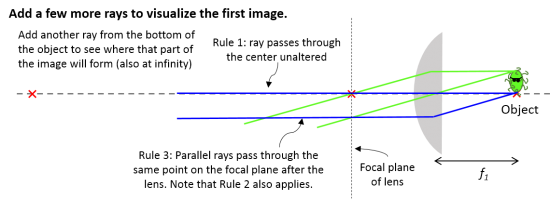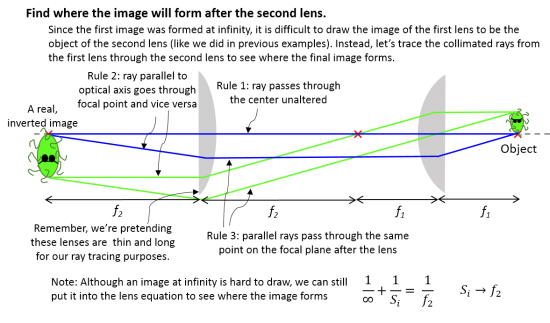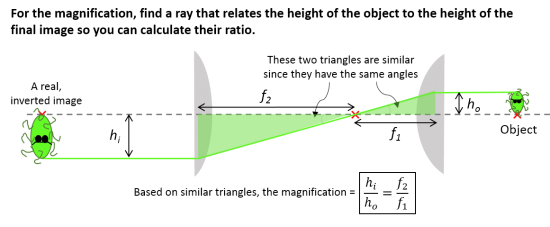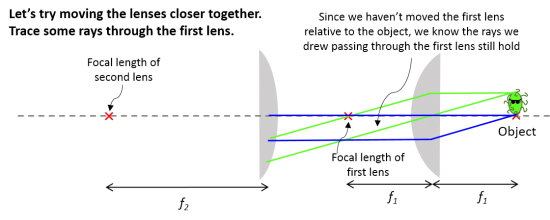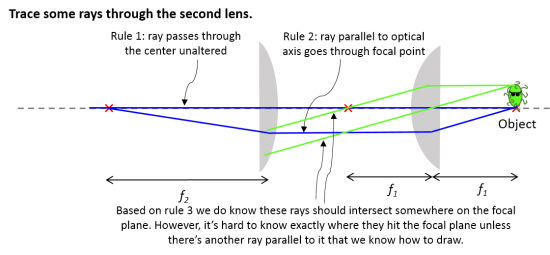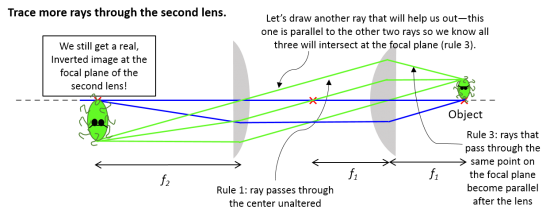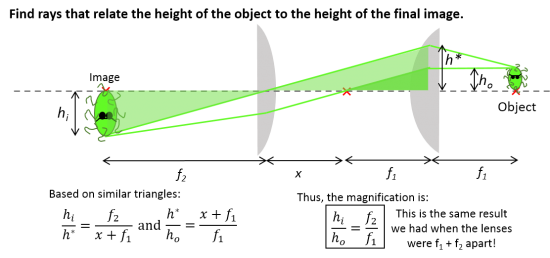Difference between revisions of "Compound Microscope Example"
(Created page with "Category:20.309 Category:Optical Microscopy Lab {{Template:20.309}} ==Example 1: Compound microscope== There is a cool bacterium you want to study in closer detail so...") |
|||
| (4 intermediate revisions by one user not shown) | |||
| Line 3: | Line 3: | ||
{{Template:20.309}} | {{Template:20.309}} | ||
| − | ==Example | + | ==Example 2: Compound microscope== |
| − | There is a cool bacterium you want to study in closer detail so you want to build a microscope to see it. You are told that you can build a microscope by placing two positive lenses (having focal lengths | + | There is a cool bacterium you want to study in closer detail so you want to build a microscope to see it. You are told that you can build a microscope by placing two positive lenses (having focal lengths <math>f_1</math> and <math>f_2</math>) at a separation distance equal to the sum of their focal lengths as shown below. |
[[File: CompoundMicroscopeExample.png|center|thumb|600px]] | [[File: CompoundMicroscopeExample.png|center|thumb|600px]] | ||
| Line 18: | Line 18: | ||
| − | Make sure you try to answer each question on your own before looking at the solutions below. | + | Make sure you try to answer each question on your own before looking at the solutions below. |
| + | |||
A) Trace the rays to show how your microscope works and where the image is formed. We will see that the image is real and inverted. | A) Trace the rays to show how your microscope works and where the image is formed. We will see that the image is real and inverted. | ||
{|class ="wikitable" style="margin: 1em auto 1em auto;" | {|class ="wikitable" style="margin: 1em auto 1em auto;" | ||
| − | |align="center" width="550"| [[Image: CompoundMicroscopeStep1.png|frameless|center| | + | |align="center" width="550"| [[Image: CompoundMicroscopeStep1.png|frameless|center|600px|]] |
|- | |- | ||
|align="center" width="550"| [[Image: CompoundMicroscopeStep2.png|frameless|center|550px|]] | |align="center" width="550"| [[Image: CompoundMicroscopeStep2.png|frameless|center|550px|]] | ||
| Line 30: | Line 31: | ||
| + | B) Calculate how much magnification you get from this optical system. | ||
| + | {|class ="wikitable" style="margin: 1em auto 1em auto;" | ||
| + | |align="center" width="550"| [[Image: CompoundMicroscopePartB.png|frameless|center|550px|]] | ||
| + | |} | ||
| + | C) Will your microscope still work if we change the distance between the lenses? | ||
| + | {|class ="wikitable" style="margin: 1em auto 1em auto;" | ||
| + | |align="center" width="550"| [[Image: CompoundMicroscopePartC1.png|frameless|center|550px|]] | ||
| + | |- | ||
| + | |align="center" width="550"| [[Image: CompoundMicroscopePartC2.png|frameless|center|550px|]] | ||
| + | |- | ||
| + | |align="center" width="550"| [[Image: CompoundMicroscopePartC3.png|frameless|center|550px|]] | ||
| + | |} | ||
| + | D) Does changing the distance between the lenses affect the amount of magnification you achieve? | ||
| + | {|class ="wikitable" style="margin: 1em auto 1em auto;" | ||
| + | |align="center" width="550"| [[Image: CompoundMicroscopePartD.png|frameless|center|550px|]] | ||
| + | |} | ||
| + | |||
| + | Back to [[Geometrical optics and ray tracing]] | ||
{{Template:20.309 bottom}} | {{Template:20.309 bottom}} | ||
Latest revision as of 17:09, 12 August 2015
Example 2: Compound microscope
There is a cool bacterium you want to study in closer detail so you want to build a microscope to see it. You are told that you can build a microscope by placing two positive lenses (having focal lengths $ f_1 $ and $ f_2 $) at a separation distance equal to the sum of their focal lengths as shown below.
A) Trace the rays to show how your microscope works and where the image is formed. Is the image real or virtual? upright or inverted? Note that this time the object is on the right and the image will form at the left.
B) Calculate how much magnification you get from this optical system.
C) Will your microscope still work if we change the distance between the lenses?
D) Does changing the distance between the lenses affect the amount of magnification you achieve?
Make sure you try to answer each question on your own before looking at the solutions below.
A) Trace the rays to show how your microscope works and where the image is formed. We will see that the image is real and inverted.
B) Calculate how much magnification you get from this optical system.
C) Will your microscope still work if we change the distance between the lenses?
D) Does changing the distance between the lenses affect the amount of magnification you achieve?



